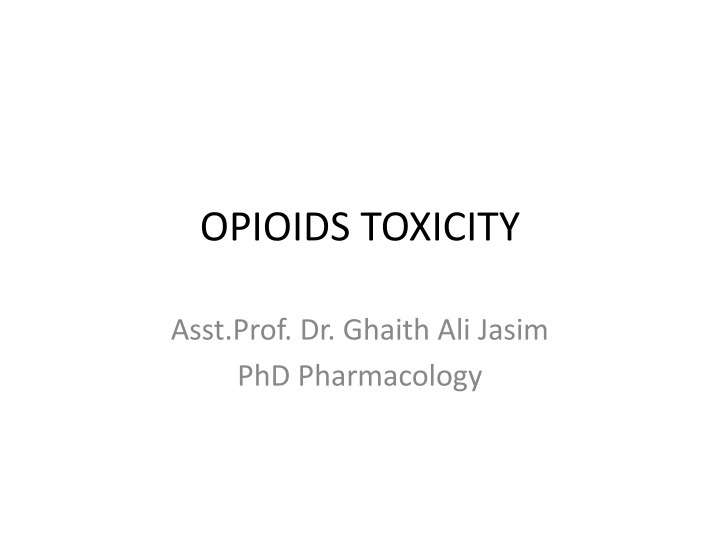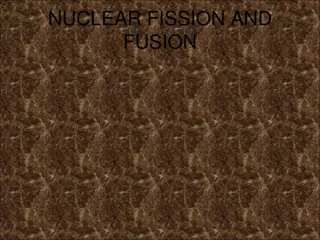
Opioids Toxicity
Exploring the world of opioids, including opiates, narcotics, and opioid receptors, their pharmacological actions, and routes of administration. Learn about the toxicity of opioids, effects on different organ systems, and the variety of opioids - natural, semi-synthetic, and synthetic.
Download Presentation

Please find below an Image/Link to download the presentation.
The content on the website is provided AS IS for your information and personal use only. It may not be sold, licensed, or shared on other websites without obtaining consent from the author. If you encounter any issues during the download, it is possible that the publisher has removed the file from their server.
You are allowed to download the files provided on this website for personal or commercial use, subject to the condition that they are used lawfully. All files are the property of their respective owners.
The content on the website is provided AS IS for your information and personal use only. It may not be sold, licensed, or shared on other websites without obtaining consent from the author.
E N D
Presentation Transcript
OPIOIDS TOXICITY Asst.Prof. Dr. Ghaith Ali Jasim PhD Pharmacology
OPIATES: Alkaloid found as a natural product in Papaver somniferum (Poppy), un-ripened seed pods.
NARCOTIC: Broader group of agents and is predominantly used by law enforcement to designate a variety of controlled substances with abuse or addictive effect, It also induces sleep. OPIOIDS: Medications that relieve pain. It applies to all natural, semi-synthetic and synthetic agents.
Natural (opiates): Heroin, Codeine, Morphine Semi-synthetic: Buprenorphine, Hydrocodone Hydromorphone, Oxycodone, Oxymorphone Synthetic: Meperidine, Propoxyphene, Tramadol Diphenoxylate, Methadone, Fentanyl Pentazocine,
Pharmacological Action Actions of opioids involve many organ systems, incl. the central nervous system (CNS), Peripheral nervous system (PNS), CVS, Respiratory system, system, and cause effects. Goals: Sedation and analgesia. and characteristic gastrointestinal clinical
Opioid receptors 1. -receptors: Analgesia, Sedation, Miosis, Respiratory depression, Cough suppression, Euphoria, Decreased GI motility. 2. -receptors: Analgesia, Sedation, Miosis, Decreased intestinal motility, Dysphoria, Hallucinations. 3. -receptors: Analgesia, some antidepressant effect, Dysphoria, Supraspinal and spinal analgesia.
Route of Administration Oral, parenteral, nasal, rectal, transdermal depending upon the lipid solubility. Heroin is usually abused through IV and S/C routes, but also absorbed after nasal administration because it is lipid soluble.
Opioid toxicity is less pronounced but more prolonged with ingestion than with parenteral administration. Absorption of opioids after ingestion occurs in the small intestine. However, because of delayed gastric emptying, absorption and clinical effects of toxicity may be prolonged after overdose.
All opioids undergo hepatic metabolism (first- pass hepatic metabolism) elimination, and variations in hepatic and renal function are metabolite activity may contribute to clinical effects and toxicity. and renal important because
Opioid Toxicity Nervous System: -Direct CNS depression -Respiratory depression hypoxia -Seizures -Hypertonicity -Myoclonus -Dysphoria -Psychosis Mepiridine & propoxyphene
Opioid Toxicity - Spongiform leuko-encephalopathy - Heroin preparation on aluminium foil chasing the dragon -Serotonin syndrome - Meperidine, methadone, tramadol - clinical triad of mental status changes, autonomic instability, and neuromuscular changes
Opioid Toxicity Respiratory System -Decrease respiratory rate and tidal volume -Bronchospasm (rare but severe) Ophthalmologic -Stimulation of - receptors in the Edinger-Westphal nuclei of the third nerve usually results in miosis.
Opioid Toxicity Otologic -Sensorineural hearing loss Cardiovascular system -Hypotension and bradycardia -Propoxyphene Na+ channel blocker acts as Class A antiarrhythmic agent prolong QRS complex -Methadone QT prolongation
Opioid Toxicity Gastrointestinal system -Nausea and vomiting -Delayed gastric emptying may lead to Ileus Other systems: -Urinary retention from urethral sphincter spasm and decreased detrusor tone -Pruritus, flushing, and urticarial -Hypoglycemia -Hypothermia
Diagnosis Diagnosis History and physical examination , ECG ,Chest X-ray ,Urine tox screen
Treatment IV Fluids Single-dose activated charcoal, 1 gram/kg PO, should be administered if the opioid ingestion occurred within the hour. Naloxone is a pure competitive antagonist at all opioid receptors, with particular affinity for - receptors, therefore fully reverses all the effects of opioid. Onset 1-2 min, duration 30-90 min. Nalmefene - opioid antagonist with a long half- life (8-11 hours) and duration of clinical effect
Opioid Withdrawal Down-regulation of opioid receptors occurs with long-term use cessation of opioid use does not allow time for up-regulation of receptors and results in increased neuronal firing and the opioid withdrawal syndrome. of opioids. Abrupt
Methadone - a long-acting opioid, provides opioid replacement to treat or to prevent withdrawal - 20 mg orally or 10 mg IM, onset 30-60 min Clonidine (central alpha2-agonist) - 0.1 mg orally, repeated every 30-60min Buprenorphine (partial agonist)
Management The consequential effects of acute opioid poisoning are CNS and respiratory depression. Early support of ventilation and oxygenation is generally sufficient prolonged use of bag-valve-mask ventilation and endotracheal intubation may be avoided by cautious administration of an opioid antagonist. to prevent death,
Management Opioid competitively agonists to opioid receptors, allowing the patient to resume spontaneous respiration. Naloxone competes at all receptor subtypes, although Not equally, and is effective at reversing almost all adverse effects Mediated through opioid receptors. antagonists, such binding as naloxone, of opioid inhibit
The necessarily complete arousal; rather, the goal is reinstitution of adequate spontaneous ventilation. Because precipitation potentially detrimental unpredictable, the lowest practical naloxone dose should be administered initially, with rapid escalation as by the clinical situation. goal of naloxone therapy is not of withdrawal and is often
Most patients respond to 0.04 to 0.05 mg of naloxone administered IV, although the requirement for ventilatory assistance may be Slightly prolonged because the onset may be slower than with larger doses.
If a naloxone bolus (start with 0.04 mg IV and titrate) is successful, administer two-thirds of the effective bolus dose per hour by IV infusion; frequently re-assess the patient s respiratory status. If respiratory depression is not reversed after the bolus dose: Intubate the patient, as clinically indicated. Administer up to 10 mg of naloxone as an IV bolus. If the patient does not respond, do not initiate an infusion.
If the patient develops withdrawal after the bolus dose: Allow the effects of the bolus to abate (become less). If respiratory depression recurs, administer half of this new bolus dose and begin an IV infusion at two-thirds of the initial bolus dose per hour. Frequently re-assess the patient s respiratory status. If the patient develops withdrawal signs or symptoms during the infusion: Stop the infusion until the withdrawal symptoms abate. Restart the infusion at half the initial rate; frequently re- assess the patient s respiratory status.
If the patient develops respiratory depression during the infusion: Readminister half of the initial bolus and repeat until reversal occurs. Increase the infusion by half of the initial rate; frequently reassess the patient s respiratory status. Exclude continued absorption, re-administration of opioid, and other etiologies as the cause of the respiratory depression.













